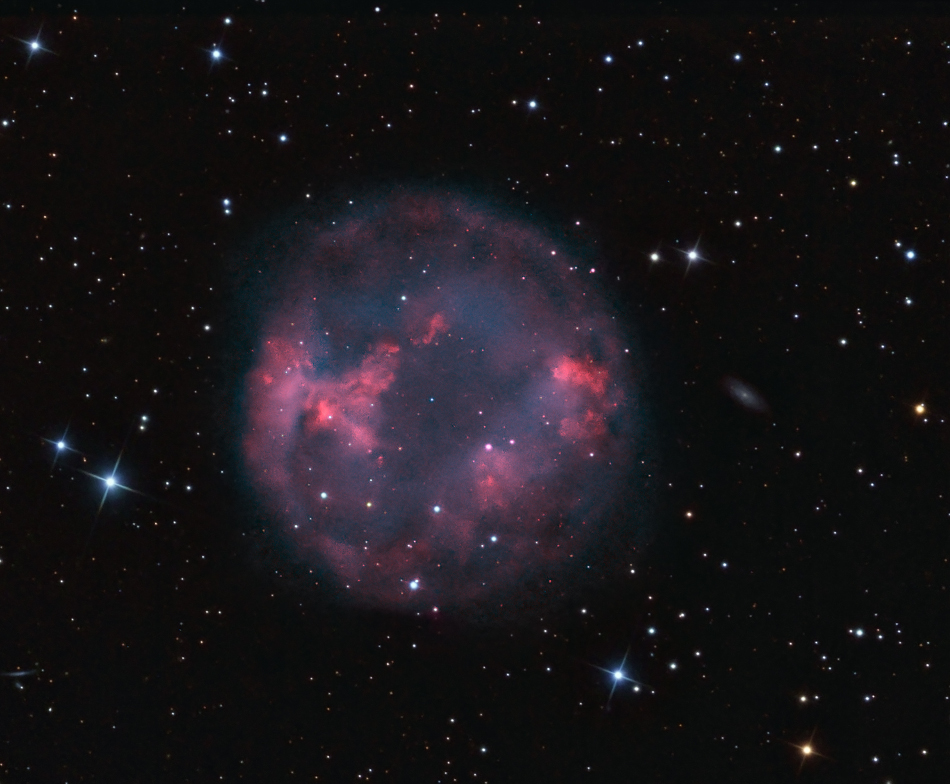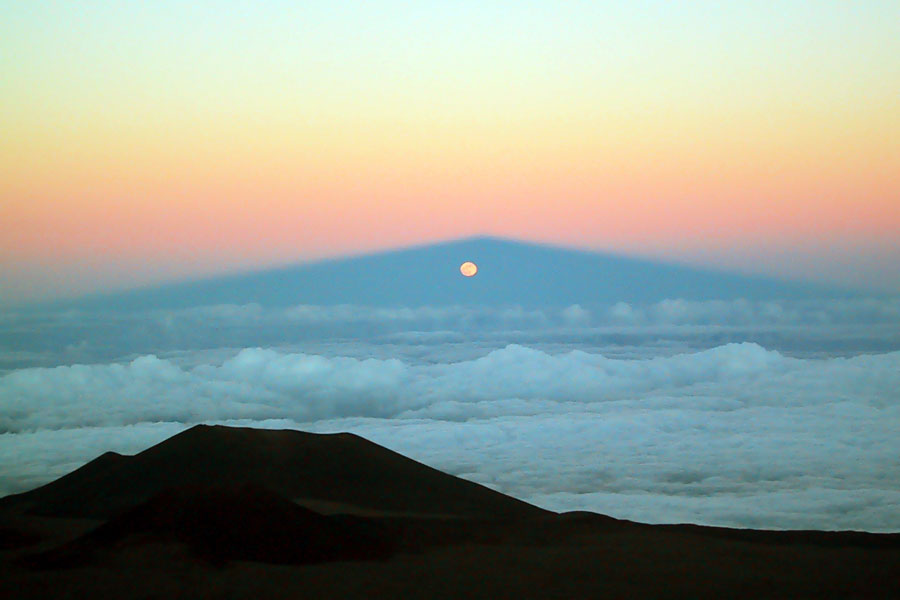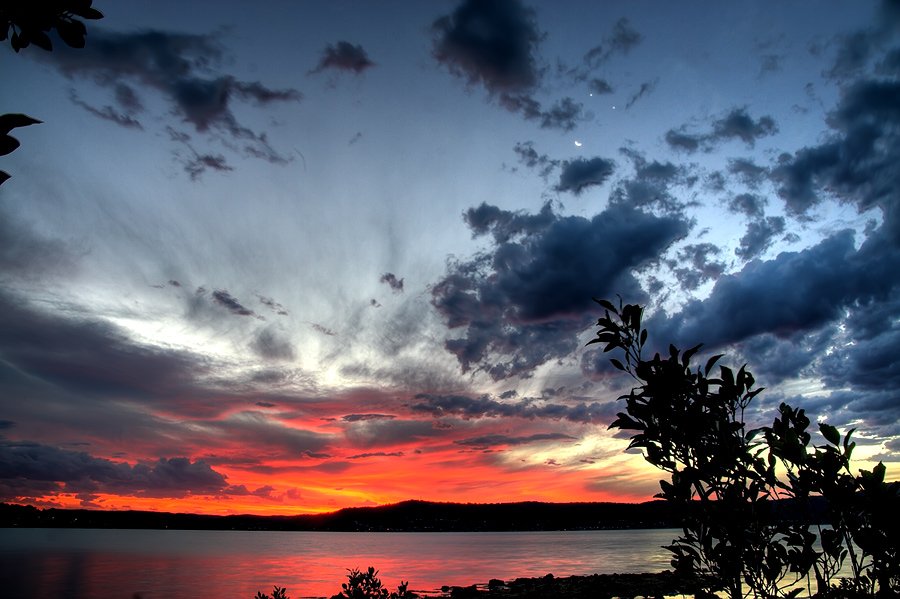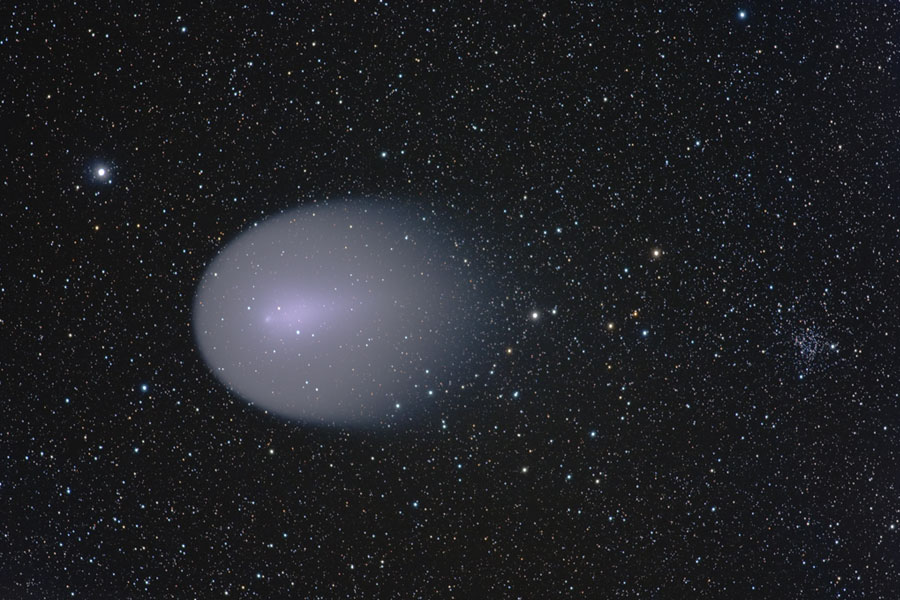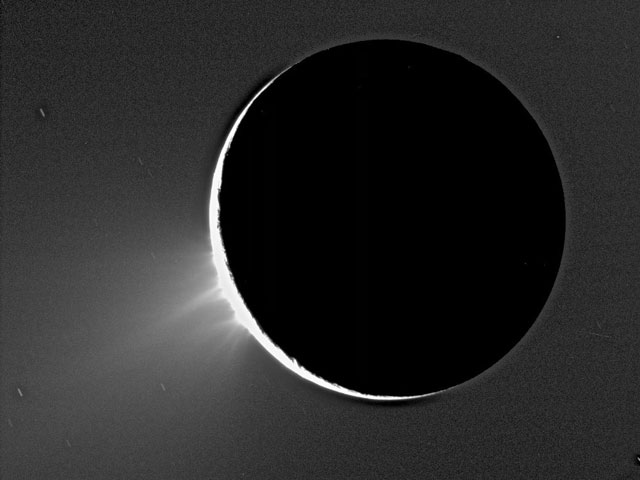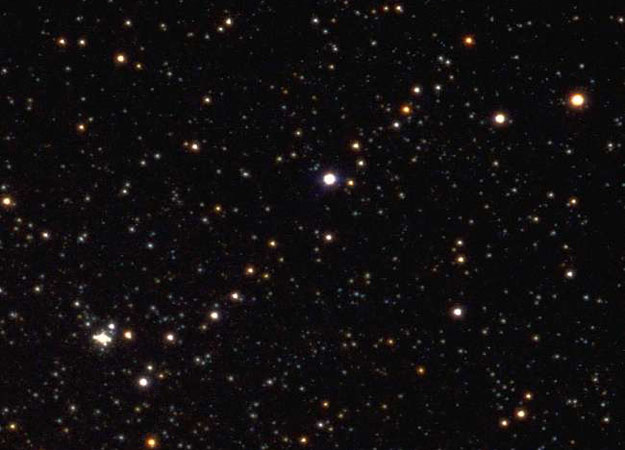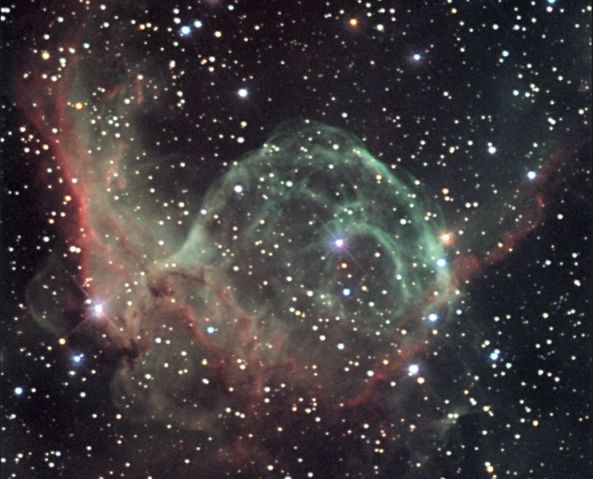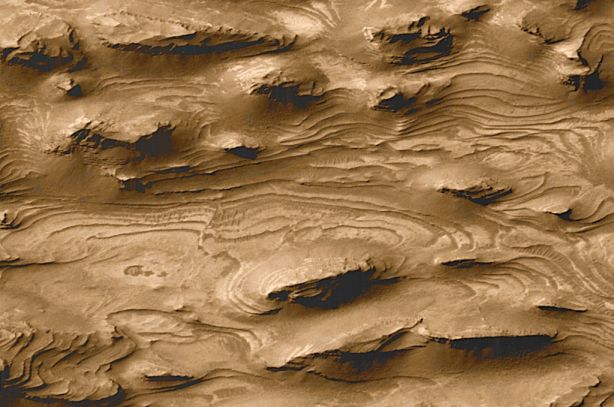| << Previous | Index | Next >> |
2014 Our Milky Way Galaxy arcs over a desolate landscape in this fantastic panoramic night skyview. The otherworldly scene looks across the arid, eroded terrain of the Valle de la Luna in the Chilean Atacama desert. Just along the horizon are lights from San Pedro, Chile, as well as the small villages of Socaire and Toconao, and a tortuous road from the city of Calama to San Pedro. Taken on October 18th, the five panel mosaic also features the four galaxies easily visible from our fair planet's dark sky regions. At the far left, satellite galaxies known as the Large and Small Magellanic Clouds are framed by their terrestrial namesakes. Much fainter and at the right, beyond the Milky Way's central bulge, is the Andromeda Galaxy. The most distant in view, Andromeda lies some 2.5 million light-years away.
2013 Very faint planetary nebula Abell 7 is some 1,800 light-years distant, just south of Orion in planet Earth's skies in the constellation Lepus, The Hare. Surrounded by Milky Way stars and near the line-of-sight to distant background galaxies, its generally simple spherical shape, about 8 light-years in diameter, is outlined in this deep telescopic image. Within its confines are beautiful, more complex details enhanced by the use of narrowband filters. Emission from hydrogen and nitrogen is shown in reddish hues with oxygen emission mapped to a bluish-green color, giving Abell 7 a more natural appearance that would otherwise be much too faint to be appreciated by eye. A planetary nebula represents a very brief final phase in stellar evolution that our own Sun will experience 5 billion years hence, as the nebula's central, once sun-like star shrugs off its outer layers. Abell 7 itself is estimated to be 20,000 years old. Its central star is seen here as a fading white dwarf some 10 billion years old.
2012
2011 It was one of the most memorable auroras of the season. There was green light, red light, and sometimes a mixture of the two. There were multiple rays, distinct curtains, and even an auroral corona. It took up so much of the sky. In the background were stars too numerous to count, in the foreground a friend trying to image the same sight. The scene was captured with a fisheye lens around and above Tromsø, Norway, last month. With the Sun becoming more active, next year might bring even more spectacular aurora.
2010 How can the Moon rise through a mountain? It cannot -- what was photographed here is a moonrise through the shadow of a large volcano. The volcano is Mauna Kea, Hawai'i, USA, a frequent spot for spectacular photographs since it is arguably the premier observing location on planet Earth. The Sun has just set in the opposite direction, behind the camera. Additionally, the Moon has just passed full phase -- were it precisely at full phase it would rise, possibly eclipsed, at the very peak of the shadow. Refraction of moonlight through the Earth's atmosphere makes the Moon appear slightly oval. Cinder cones from old volcanic eruptions are visible in the foreground. Cloud tops below Mauna Kea's summit have unusually flat tops, indicating a decrease in air moisture that frequently keeps the air unusually dry, another attribute of this stellar observing site.
2009
[imghover6=http://apod.nasa.gov/apod/image/0912/Hi ... freshi.jpg]http://apod.nasa.gov/apod/image/0912/Hi ... freshi.jpg[/imghover6]Credit & Copyright: Babak Tafreshi (TWAN)
2008 At sunset, Monday's western sky showed off stunning colors and dramatic clouds reflected in Brisbane Water on the Central Coast of New South Wales, Australia. It also featured the remarkable conjunction of the crescent Moon, Venus, and Jupiter forming a twilight smiley face. While the gathering of the two bright planets and Moon awed skygazers around planet Earth, astronomer Mike Salway reports taking special pains to record this gorgeous view, braving mosquitos and rain squalls along a soggy shore. His southern hemisphere perspective finds brilliant Venus at the highest point in the celestial grouping. For now, a bright pairing of Venus and Jupiter continues to dominate the western horizon after sunset but the Moon has moved on and tonight is near its first quarter phase.
2007 Comet Holmes refuses to fade. The unusual comet that surprisingly brightened nearly a million-fold in late October continues to remain visible to the unaided eye from dark locations. Night to night, Comet 17P/Holmes is slowly gliding through the constellation Perseus, remaining visible to northern observers during much of the night right from sunset. Pictured above, Comet Holmes was captured from Hungary last week. The remarkable snowball continues to retain a huge coma, but now shows very little of a tail. To the far right is the open cluster of stars NGC 1245. How much longer Comet Holmes will remain visible to the unaided eye is unknown.
2006 What is it? It was found at the bottom of the sea aboard an ancient Greek ship. Its seeming complexity has prompted decades of study, although many of its functions remained unknown. Recent X-rays of the device have now confirmed the nature of the Antikythera mechanism, and discovered several surprising functions. The Antikythera mechanism has been discovered to be a mechanical computer of an accuracy thought impossible in 80 BC, when the ship that carried it sunk. Such sophisticated technology was not thought to be developed by humanity for another 1,000 years. Its wheels and gears create a portable orrery of the sky that predicted star and planet locations as well as lunar and solar eclipses. The Antikythera mechanism, shown above, is 33 centimeters high and similar in size to a large book.
2005 Fountains of ice shoot out from Saturn's moon Enceladus. Clear discovery images of the fountains were made using observations from the robot Cassini spacecraft currently orbiting Saturn. During a recent pass, Cassini was programmed to look back toward the Sun where Enceladus would appear as a thin crescent. From this vantage point, particles emitted from the surface would better show themselves by reflecting sunlight. The tactic was successful -- the above frame shows several plumes emanating from regions previously known to contain gashes in the surface dubbed tiger stripes. Cassini detected an increase in particle emissions from these regions during a July flyby. Some of these ice particles likely contribute to the make up of Saturn's mysterious E ring.
2004 A picturesque chain of unrelated stars is visible with strong binoculars towards the constellation of Camelopardalis. Known as Kemble's Cascade, the asterism contains about 20 stars nearly in a row stretching over five times the width of a full moon. Made popular by astronomy enthusiast Lucian Kemble (1922-1999), these stars appear as a string only from our direction in the Milky Way Galaxy. The above photograph of Kemble's Cascade was made with a small telescope in New Mexico, USA. The bright object near the bottom left is the relatively compact open cluster of stars known as NGC 1502.
2003 Variable star V838 Monocerotis startled astronomers in January of 2002, undergoing a dramatic outburst like no other variable star known. Followed closely by ground-based instruments and the Hubble Space Telescope over the following months, it was soon realized that the quickly evolving dusty nebula surrounding V838 Mon was in fact made visible by "light echoes" from the outburst. Remarkably, as light from the outburst plays across layers of pre-existing circumstellar material, it gives the surrounding nebulosity the illusion of expanding "faster than light". Though the nebula's visible appearance changes dramatically over a period of months, it is actually at least 6 light years in diameter. A good astrophysical explanation for V838 Mon's outbursting behavior is still unknown but astronomers continue to follow the mystery star. This gorgeous image, based on data recorded on October 21 with the US Naval Observatory's 1.55 meter telescope, adopts the color scheme used in previous Hubble images for easy comparison.
2002 NGC 2359 is a striking emission nebula with an impressive popular name - Thor's Helmet. Sure, its suggestive winged appearance might lead some to refer to it as the "duck nebula", but if you were a nebula which name would you choose? By any name NGC 2359 is a bubble-like nebula some 30 light-years across, blown by energetic winds from an extremely hot star seen near the center and classified as a Wolf-Rayet star. Wolf-Rayet stars are rare massive blue giants which develop stellar winds with speeds of millions of kilometers per hour. Interactions with a nearby large molecular cloud are thought to have contributed to this nebula's more complex shape and curved bow-shock structures. NGC 2359 is about 15,000 light-years distant toward the constellation Canis Major.
2001 In the early morning hours of November 19, amateur Chen Huang-Ming caught a sky filled with astronomical wonders. With his fisheye camera set up on Ho-Huan Mountain in Taiwan for a half-hour exposure, he started the above image a local time of 2:33 am. First, the many famous stars and nebulas captured are too numerous to count. Planets Jupiter and Saturn are visible, while the plane of our Milky Way Galaxy sweeps diagonally across the image. What makes this image most spectacular, however, are the over 100 bright meteors visible from the 2001 Leonids Meteor Shower. The meteor shower is caused by the Earth plowing through a stream of sand-sized ice particles shed years ago by Comet Tempel-Tuttle. Note that the meteors can all be tracked back to a radiant in the constellation Leo, the direction from which the particles orbit the Sun.
2000 Pictured above, layers upon layers stretch across the floor of West Candor Chasma within the immense martian Valles Marineris. Covering an area 1.5 by 2.9 kilometers, the full image from the Mars Global Surveyor spacecraft shows over 100 individual beds. Each strikingly uniform layer is smooth, hard enough to form steep edges, and is 10 to 11 meters thick. In a press conference yesterday scientists Michael Malin and Ken Edgett presented this and other new images which show that the layered patterns exist at widespread locations near the martian equator. Their results indicate that some of the layered regions may be 3.5 billion years old. On planet Earth, layered patterns like these are formed from sediment deposited over time by large bodies of water. Likewise, the layered beds on Mars may be sedimentary rock formed in ancient lakes and seas. The researchers caution, however, that other uniquely martian processes may be responsible for the layering. Did life arise on ancient Mars? Because of their possible association with water, a prime location for future searches for fossil remains of martian life would be within these layers of Mars.
1999 Rhea is the second largest moon of Saturn, behind Titan, and the largest without an atmosphere. It is composed mostly of water ice, but has a small rocky core. Rhea's rotation and orbit are locked together (just like Earth's Moon) so that one side always faces Saturn. A consequence of this is that one side always leads the other. Rhea's leading surface is much more heavily cratered than its trailing surface. The above photograph was taken with the Voyager 1 spacecraft in 1980.
1998 This panorama of the cratered lunar surface was constructed from images returned by the US Surveyor 6 lander. Surveyor 6 was not the first spacecraft to accomplish a soft landing on the Moon ... but it was the first to land and then lift off again! After touching down near the center of the Moon's nearside in November of 1967, NASA controllers commanded the spacecraft to hop. Briefly firing its rocket engine and lifting itself some 4 meters above the surface, the Surveyor moved about 2.5 meters to one side before setting down again. The hopping success of Surveyor 6 essentially marked the completion of the Surveyor series main mission - to determine if the lunar terrain was safe for the planned Apollo landings.
1997 In this dramatic picture, spiral galaxy NGC 5091 appears in the foreground. Tilted nearly edge-on, the dust lanes between its spiral arms are clearly visible. The large elliptical galaxy NGC 5090 lies just beyond it - both are about 100 million light years distant in the southern constellation Centaurus. Can you see through the spiral galaxy? The detailed answer to this question has important implications for determining the nature of dark matter and the measurement of star formation rates. Comparing the overlapping and non-overlapping parts of this and other pairs of galaxies offers a neat way to find the answer.
1996 Io has some very large volcanoes. One of the largest is evident near the center of the above photograph and named Pele, for the mythological Polynesian fire goddess. The Galileo spacecraft now orbiting Jupiter took this picture of Jupiter's most active moon in June, although it was released just last week. Evident around Pele is a large red ring, thought to be evidence of recent volcanic activity. The red color indicates the presence of Sulfur, although how the Sulfur was produced is not precisely known.
1995 What evil lurks in the hearts of galaxies? The above picture by the Hubble Space Telescope of the center of the nearby galaxy NGC 4261 tells us one dramatic tale. Here gas and dust are seen swirling near this elliptical galaxy's center into what is almost certainly a massive black hole. The disk is probably what remains of a smaller galaxy that fell in hundreds of millions of years ago. Collisions like this may be a common way of creating such active galactic nuclei as quasars. Strangely, the center of this fiery whirlpool is offset from the exact center of the galaxy - for a reason that for now remains an astronomical mystery.
| << Previous | Index | Next >> |

